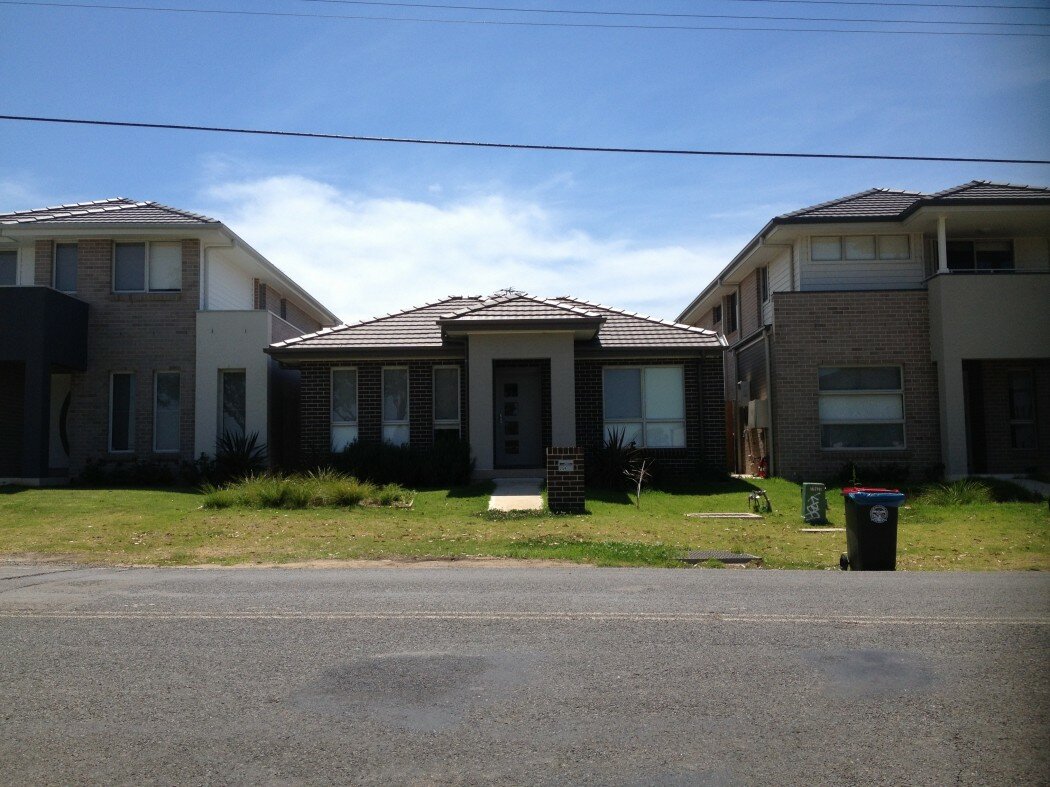I live in a suburb of Sydney that was mostly developed in the 1990s. When my parents decided to build their own home here they bought a block of land they liked, picked a design from a show home that suited them and had it built. I really enjoyed living there. The blocks around us were eventually bought and built on. The streets were wide enough for parked cars and to safely ride a bicycle on the road. The rooms were decently sized enough for me to have a single bed, side table, dressing table, a writing desk and even a bookshelf comfortably in there. The main bathroom spoiled all bathrooms since for my sister and I, and the ensuite served my parents very tolerably. The house was well-built, my parents picked quality fittings and it suited us equally as children as it did when we were teenagers and young adults.
The areas around the suburb we live in are being developed now. Most of the roads that used to only service farmland that we used as a back route to my Grandparents’ place on the cusp of Sydney and the Blue Mountains are being subdivided and having houses built. But it isn’t the way my parents chose their house. A developer comes in, builds a whole heap of houses that look nearly the same and sells them off, sometimes to people who want to live there, sometimes to people who want an investment property to rent out. These new areas are places I would not actually want to live.
The main roads, which are currently gutterless two lane roads, have not been upgraded to cope with the extra traffic. The intersections on the main roads have become dangerous; if I drive out there between 7:30 and 9 am I can wait 15 minutes for a gap in traffic to turn right off a main road. The council has ‘plans’ to upgrade certain intersections but those plans are in two years and that doesn’t help prevent the accidents that are happening now.
The residential streets are so narrow that street parking on just one side of the street means that cars can’t pass each other. I know that these have always been difficulties in inner city suburbs, but this is an area with a very limited public transport network, basically you can get to the City or Parramatta, but not a suburb that doesn’t lie directly in that way. People might expect that residents would park in their garage, but these are four bedroom houses with single car garages and not much driveway to park in. And of course parking on the nature strip is illegal. And what if someone has a party or invites friends over? There just isn’t adequate parking for an area where people rely on cars if you make the roads too narrow. It’s not like space is at a premium, these are developments that are still in between farms.
And the houses are cramped in, with little to no eaves, which is incredibly impractical with the heat we get. In addition to this most of them haven’t been insulated. Insulation makes a huge difference in the liveability of a house. I noticed when we moved out of our house that my parents had insulated as we moved to a house in the same area that had not been insulated. We now run an air conditioner so we don’t expire on hot days. But air conditioning is an expensive solution to the problem of having a house that heats up like a tin bucket on hot days.
In order to sell for higher prices bedroom size has been significantly reduced. The rooms are too small to get a bed and a dressing table in. I don’t know exactly how anyone would comfortably live without a dressing table. It’s where I do my hair and my makeup and keep about half of my clothing. And you couldn’t do your makeup in the bathrooms if you had to share with anyone, most of them have a basin the size of a breakfast bowl and two drawers the size of postage stamps. Not only that, the fittings are cheap and break easily, faux stainless steel rusts pretty damn quickly in the Australian climate, and within a decade most of these places will be in dire need of a refurbish.
The Sydney housing market is such that people are forced to live in these areas because there isn’t much else option available. Particularly for people who have a certain budget. And I feel incredibly lucky that I am not in the Sydney rental or property market, by the virtue of my parents being quite happy to have me still at home. It used to be that if you lived in an outer suburb you were compensated for your commute time by having a backyard large enough to keep a full size dog and a relatively spacious home. Now you have to live in an inoperative suburb without the benefits of a short commute, a sea breeze or proximity to the services that come with living in an inner suburb.
You may argue that perhaps we should all just learn to live with less stuff and less space and get on with it. But there are a lot of difficulties that come from living in a poorly planned suburb. My sister lives in the Queensland equivalent of one of these suburbs (it’s not just a NSW problem) and suffers constant antipathy with her neighbours putting her bins in her driveway (even though she puts them out the night before, and takes them in when she gets home) getting narky because she or her roommate have parked in ‘their’ spot (even though it’s unallocated street parking). Being unable to get in or out of the street because there is too much traffic going both ways that can’t pass each other because of parked cars. Surely this isn’t something anyone should just learn to put up with.
But why are suburbs like this even allowed to be built? Where is the person to look at the plans and go ‘wait a second, cars won’t actually be able to navigate a street that narrow’? Or ‘if you’re going to build houses that are unsuitable for the climate at least insulate them’? I can understand the developers want to make money but I had been naive enough to think that the local government were actually supposed to serve the people, the residents of these suburbs. But no, they just want to maximise the amount of property tax they get so that it can go back into… wait a second, what is it going back into? The roads haven’t been upgraded, in fact one of the most congested roads’ upgrade is being paid for by the local shopping centre. The public transport hasn’t really improved, and the only improvement in the works is being paid for by the state government, but that will only really take you to the city, so it will probably take more people off buses than it will take people out of cars.
All in all I feel a bit cheated by both the local and state government for allowing housing developments that only work in shiny brochures with artists’ conceptual drawings where no one actually lives or drives in them. If the government isn’t protecting people from being economically forced into living in impractical housing estates then what exactly is the point of the state and local governments? We might as well go back to a laissez-faire system where we pay much less tax. These estates are being built to maximise profits with no regard for the end user. I understand that there is a need for higher density housing with population growth, but there are well designed medium housing areas, with adequate roads and transport. I have seen small houses that feel bigger than much larger ones because the space is well used and doesn’t have an extra bedroom or bathroom over-ambitiously cramped in to move it to the price bracket of a four bedroom home. Something well planned and well built that will actually have some longevity and, I don’t know, actually works.
What do you think about developments in your area? Are you annoyed when things are built that don’t practically work?









Pingback: This Week: Overwhelmed | KiKi & Tea()